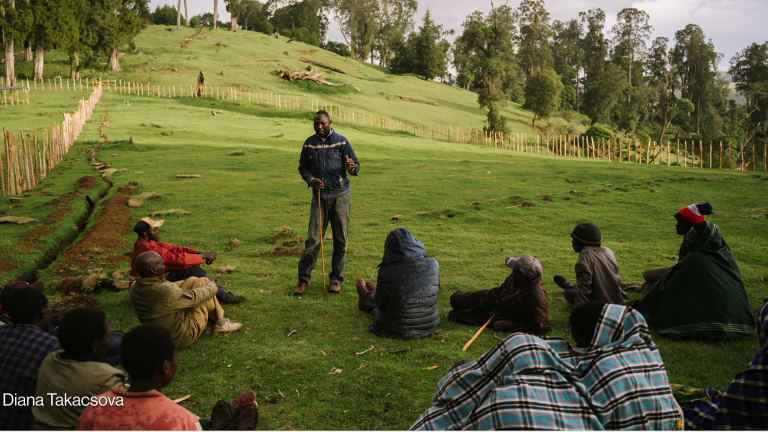
BONN, Germany — The former president of Mexico, Felipe Calderón, thinks that most degraded land can be restored in a profitable way — but “creative” approaches are needed to make restoration projects attractive to investors.
Speaking at the Global Landscapes Forum in Germany this week, Calderón talked about the urgent need to restore the world’s degraded land — estimated at 2 billion hectares — and how it can offer governments, companies, and communities both economic and social returns. While stressing the need to preserve pristine forest, Calderón told Devex that “most degraded land could be recovered in a profitable way, in my opinion,” but “you need to be careful that you don’t compete with the nature of the original forest.”
Restoration, which was a dominant theme at this year’s GLF, refers to the practice of regaining the ecological integrity of land that has been deforested or degraded, usually due to logging and over-farming. It is most often restored by planting trees. While the concept has been around for some time, it has gained widespread momentum in recent years, for example, through the launch of the Bonn Challenge in 2011 in which more than 40 countries pledged to restore 150 million hectares of deforested and degraded lands by 2020. Some African countries also made specific commitments under the African Forest Landscape Restoration Initiative.
However, despite growing enthusiasm for the restoration agenda, the question remains of how to finance the ambitious plans set by governments.
According to Calderón — an established champion of climate solutions, who is also no stranger to the competing interests facing governments — creative solutions are needed in order to give landscapes a “market value.” This includes policy change, such as removing subsidies for cattle farming and fertilizer, but also new approaches, such as sponsoring entrepreneurs to start restoration projects that can then be sold later.
“There is this dominant European perception of reality, where the problem is more with industry, energy, and cities, much less with forestry. But for developing countries, their reality and their direct contact with the problem is with forestry and landscapes.”
— Felipe Calderón, former president of MexicoHe also talked about the need for a change in “perspective” among the European countries and donors currently leading the climate agenda away from energy and toward the issues around landscapes and forests that are more relevant to developing countries, he said. The former Mexican president made his remarks during a launch event for a new World Resources Institute report, held on the sidelines of the GLF, which outlines the barriers, and potential solutions, to attracting greater investment to restoration.
Devex sat down with Calderón after the launch to talk about how to harness the potential of the restoration agenda, and how European actors can change their approach to help facilitate it. The conversation has been edited for length and clarity.
You said during your presentation that while Europe has been leading efforts to address climate change, that these often come from a European perspective, which is not necessarily that relevant to developing countries. Can you tell me more about that?
My sense — from my experience at the Global Commission on the Economy and Climate and from reading a lot of reports, which are honestly very well done — is that the emphasis of both research and statements is energy-oriented, with a lot of examples and financial estimations about energy … But very few talk about land use and restoration and forestry.
There is this dominant European perception of reality, where the problem is more with industry, energy, and cities, much less with forestry. But for developing countries, their reality and their direct contact with the problem is with forestry and landscapes.
Even in medium-income countries like Colombia, the main source of carbon emission is cattle and you cannot find enough information in the reports about this problem. It’s not a criticism about the European mission, but there is a way to improve and enrich the understanding of these issues.
What are some of the main barriers facing the restoration movement and what can be done to overcome them?
The main point of the WRI report is that institutions and governments face technical issues regarding three aspects of restoration project financing. One is the size; one is the long-term nature of the projects; and one is the risk.
“Most degraded land could be recovered in a profitable way, in my opinion. There are a lot of examples, but you need to be careful that you don’t compete with the nature of the original forest.”
—To address the size, it is important to pack and bundle the projects, and in that way create scale. Civil society and NGOs could play a role in this, even beyond what governments could do.
On the problems associated with long-term versus short-term project times, this comes down to risk being associated with the highest interest rates … so development banks could smooth and reduce those interest rates by bearing part of the risk … or providing collateral. But they are risk averse for greenfield projects — and it’s absurd, well it’s human, but the whole idea of these institutions is to deal with that risk.
So maybe we can split and divide up the projects and establish some kind of milestones or tranches … in which we can treat greenfield projects differently to projects that are already in place. One idea could be to design a specific public policy to promote startups in greenfield projects. For instance, a group of students could try to start a plantation or reforestation project and get paid for that and sell the project in year two, three, or four. For a company that is risk averse to greenfield projects, it is much better to see the trees in year four.
But who are the investors that might be willing to buy or invest in these projects once they are up and running?
I understand that there are a lot of mutual funds with a clear mandate to invest some percentage of their funds in green projects. At same time, the mutual funds are interested in the long term … because they have long-term liabilities, so they don’t need the money exactly right now. They cannot invest in a greenfield project … but they can take on a running plantation, even if it’s in the early stage of implementation, knowing that they can probably get very big returns in the long term. So some thinking about redesigning public policy for this needs to happen.
I remember my own experience in Mexico trying to foster a highway project. A lot of people and companies and investment funds were interested in the highways once they were built, but would not provide the finance to build them. So we decided to start building, and three years later we could sell at a much higher value. With that money, we created an investment fund so we could build it, then sell it, then replenish the fund. We can do something similar for restoration, either by directly investing or by promoting startups to do it and then selling the projects on.
What about the risks, for example, of planting monocultures or causing further deforestation?
Yes, there are downsides definitely, but you can manage them in a very sustainable way. Of course you cannot substitute natural forest for any plantation. I come from a state, Michoacán, which is the most beautiful state around the globe, but we used to produce half the total production of avocado in the world. Now, these guys were so successful they started to log down the trees and the wood and it’s a permanent battle between the government and agencies against the farmers.
It’s a good example … if the avocado is seeded in formerly very poor lands — because the indigenous communities needed to feed themselves and they logged down the forest a long time ago, and seeded maize and corn, and they were getting one tonne per hectare, which is incredibly poor — we’re talking about $100 a year, it’s nothing. However, if you support them to restore that specific land you can harvest and grow avocados [and provide more income, which incentivizes people to stop degrading the land.]
Most degraded land could be recovered in a profitable way, in my opinion. There are a lot of examples, but you need to be careful that you don’t compete with the nature of the original forest.
Read more Devex coverage on land matters.








